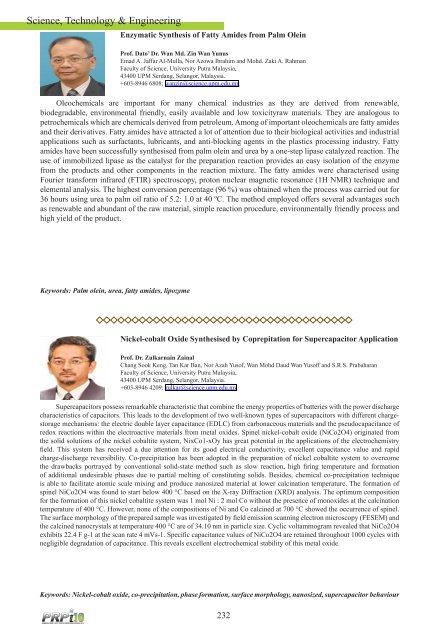BUKU ABSTRAK - Universiti Putra Malaysia
BUKU ABSTRAK - Universiti Putra Malaysia
BUKU ABSTRAK - Universiti Putra Malaysia
You also want an ePaper? Increase the reach of your titles
YUMPU automatically turns print PDFs into web optimized ePapers that Google loves.
Science, Technology & Engineering<br />
Keywords: Palm olein, urea, fatty amides, lipozyme<br />
Enzymatic Synthesis of Fatty Amides from Palm Olein<br />
Prof. Dato’ Dr. Wan Md. Zin Wan Yunus<br />
Emad A. Jaffar Al-Mulla, Nor Azowa Ibrahim and Mohd. Zaki A. Rahman<br />
Faculty of Science, University <strong>Putra</strong> <strong>Malaysia</strong>,<br />
43400 UPM Serdang, Selangor, <strong>Malaysia</strong>.<br />
+603-8946 6808; wanzin@science.upm.edu.my<br />
Oleochemicals are important for many chemical industries as they are derived from renewable,<br />
biodegradable, environmental friendly, easily available and low toxicityraw materials. They are analogous to<br />
petrochemicals which are chemicals derived from petroleum. Among of important oleochemicals are fatty amides<br />
and their derivatives. Fatty amides have attracted a lot of attention due to their biological activities and industrial<br />
applications such as surfactants, lubricants, and anti-blocking agents in the plastics processing industry. Fatty<br />
amides have been successfully synthesised from palm olein and urea by a one-step lipase catalyzed reaction. The<br />
use of immobilized lipase as the catalyst for the preparation reaction provides an easy isolation of the enzyme<br />
from the products and other components in the reaction mixture. The fatty amides were characterised using<br />
Fourier transform infrared (FTIR) spectroscopy, proton nuclear magnetic resonance (1H NMR) technique and<br />
elemental analysis. The highest conversion percentage (96 %) was obtained when the process was carried out for<br />
36 hours using urea to palm oil ratio of 5.2: 1.0 at 40 ºC. The method employed offers several advantages such<br />
as renewable and abundant of the raw material, simple reaction procedure, environmentally friendly process and<br />
high yield of the product.<br />
Nickel-cobalt Oxide Synthesised by Coprepitation for Supercapacitor Application<br />
Prof. Dr. Zulkarnain Zainal<br />
Chang Sook Keng, Tan Kar Ban, Nor Azah Yusof, Wan Mohd Daud Wan Yusoff and S.R.S. Prabaharan<br />
Faculty of Science, University <strong>Putra</strong> <strong>Malaysia</strong>,<br />
43400 UPM Serdang, Selangor, <strong>Malaysia</strong>.<br />
+603-8946 4209; zulkar@science.upm.edu.my<br />
Supercapacitors possess remarkable characteristic that combine the energy properties of batteries with the power discharge<br />
characteristics of capacitors. This leads to the development of two well-known types of supercapacitors with different chargestorage<br />
mechanisms: the electric double layer capacitance (EDLC) from carbonaceous materials and the pseudocapacitance of<br />
redox reactions within the electroactive materials from metal oxides. Spinel nickel-cobalt oxide (NiCo2O4) originated from<br />
the solid solutions of the nickel cobaltite system, NixCo1-xOy has great potential in the applications of the electrochemistry<br />
field. This system has received a due attention for its good electrical conductivity, excellent capacitance value and rapid<br />
charge-discharge reversibility. Co-precipitation has been adopted in the preparation of nickel cobaltite system to overcome<br />
the drawbacks portrayed by conventional solid-state method such as slow reaction, high firing temperature and formation<br />
of additional undesirable phases due to partial melting of constituting solids. Besides, chemical co-precipitation technique<br />
is able to facilitate atomic scale mixing and produce nanosized material at lower calcination temperature. The formation of<br />
spinel NiCo2O4 was found to start below 400 °C based on the X-ray Diffraction (XRD) analysis. The optimum composition<br />
for the formation of this nickel cobaltite system was 1 mol Ni : 2 mol Co without the presence of monoxides at the calcination<br />
temperature of 400 °C. However, none of the compositions of Ni and Co calcined at 700 °C showed the occurrence of spinel.<br />
The surface morphology of the prepared sample was investigated by field emission scanning electron microscopy (FESEM) and<br />
the calcined nanocrystals at temperature 400 °C are of 34.10 nm in particle size. Cyclic voltammogram revealed that NiCo2O4<br />
exhibits 22.4 F g-1 at the scan rate 4 mVs-1. Specific capacitance values of NiCo2O4 are retained throughout 1000 cycles with<br />
negligible degradation of capacitance. This reveals excellent electrochemical stability of this metal oxide.<br />
Keywords: Nickel-cobalt oxide, co-precipitation, phase formation, surface morphology, nanosized, supercapacitor behaviour<br />
232



